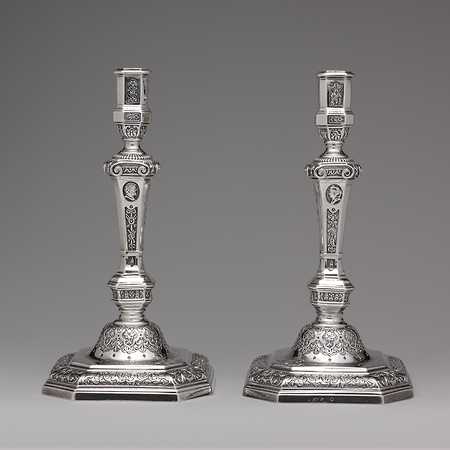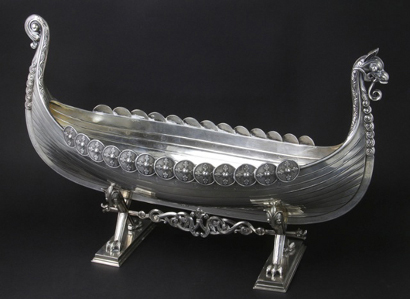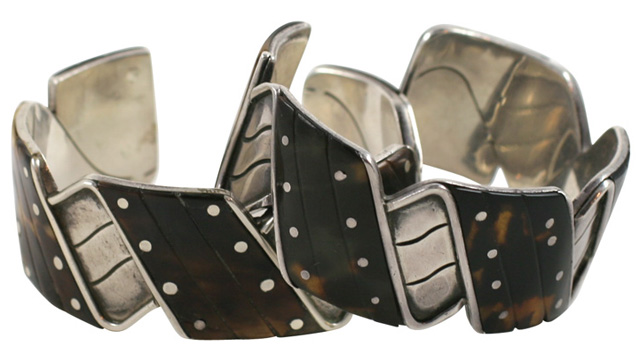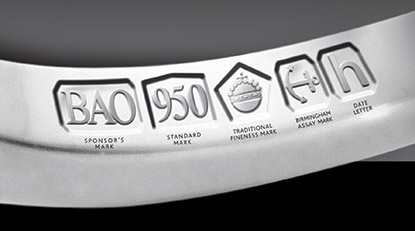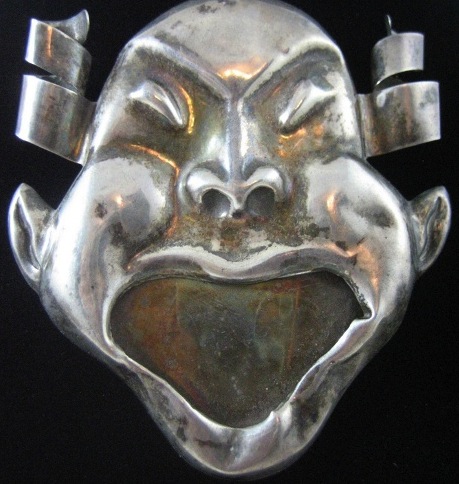Pictured: Pair of candlesticks, 1690–92
French; Paris
Silver Each H. 9 1/4 in. (23.5 cm)
Bequest of Catherine D. Wentworth, 1948 (48.187.249,.250)
Silver has always held an exalted position within the decorative arts. The fact that it is a precious metal distinguishes it from other media such as porcelain, wood, and glass, which do not have inherent value. The monetary value of silver usually meant that objects made in silver had more than just a utilitarian purpose; they were also signs of wealth and status, and as such, often reflected the latest style. Silver could be melted down and refashioned, and as the value of a silver object in the eighteenth century lay more in the metal than in the craftsmanship, pieces of silver thought to be out of date were often melted and transformed into something more fashionable. French silver was also subject to the various fiscal crises of the late seventeenth and eighteenth centuries; both Louis XIV and Louis XV issued edicts demanding that silver be brought to the mint for melting, the resulting silver to be used to replenish depleted state treasuries. Thus, French silver from the seventeenth and first half of the eighteenth centuries survives in relatively small quantities.
The strict guild system in France helped to ensure the very high quality typically found in French silver. A prospective silversmith usually served an eight-year apprenticeship, and then spent two to three years as a journeyman. Then, in order to be recognized as a master, the journeyman submitted a trial work—his “masterpiece”—by which his skills could be judged. It was only after acceptance of this object by the guild, and after a final examination, that the status of master was obtained. The guild’s marking system also ensured the quality of the metal itself. Among the marks required for a piece of silver, the warden’s mark indicated that the silver content was correct. As silver in its pure state was too soft to form a durable object, a small amount of copper was always added to the molten silver to provide additional strength. In France, the silver standard required that 958.33 parts out of a thousand must be silver.
The best known silver objects made during the reign of Louis XIV were the pieces of silver furniture—console tables, torcheres, mirrors, etc.—produced for Versailles. These pieces were melted down in the late seventeenth century as a result of Louis XIV’s own edict, but more domestically scaled silver survives from the last decades of Louis’s reign, albeit in small quantities. Among the earliest French silver now in the Museum are a fork and spoon dating to the years 1683–84 (48.187.214,.215). It was only at this time that the notion of a matched fork and spoon was gaining acceptance; knives were not even a standard accompaniment to a fork and spoon at this date.
The introduction of tea and coffee into France in the seventeenth century provided an important impetus for the development of new forms in silver. The earliest surviving Parisian silver teapot appears to be one now in the Museum (48.187.78). Its marks indicate that it was made in 1699–1700, and it is recorded that a drawing of a very similar teapot was sent in 1702 to Sweden, where French fashions in silver and other decorative arts were extremely influential. Dating to the mid-eighteenth century is a coffeepot of an unusually innovative and daring design (33.165.1). The coffee leaves and berries that decorate the spout and the base of the handle are a clever reference to the function of the pot, and the spiraling channels of the body create a sense of movement that captures an essential feature of the Rococo style, which was at the height of its popularity during these years.
Dining habits changed significantly in the course of the late seventeenth and eighteenth centuries. The French custom of placing food on the table in tureens and platters arranged decoratively became known as service à la française, and this style of dining, in which one served oneself, became the standard throughout Europe. The service à la française encouraged the development of the tureen, which became the dominant—and most expensive—feature of the table. One of the most elaborate French eighteenth-century tureens is that made for the duc de Penthièvre (48.187.418a-c). Its most notable feature is the highly sculptural finial or handle on the lid, which is composed of three hounds pulling down a stag—perhaps suggesting that a venison stew might have been the tureen’s contents. Also intended for use on the dining table are two candelabra (48.187.389ab,.390ab), probably from an original group of eight or twelve. They bear the marks of the great silversmith Robert-Joseph Auguste (1723?–1805), who became silversmith to the king in 1778. These candelabra date to early in Auguste’s career, and their bold, sculptural style, drawing upon architectural motifs from classical antiquity, reflects the emerging Neoclassicism of the late 1760s. A more spare, less robust use of classical motifs is evident in a ewer of 1784–85 (1980.79), in which the dominant sculptural element is the half-figure of Narcissus that forms the handle. Narcissus gazes down upon the reflective surface of the cover, thus representing the legend of Narcissus in a subtle but highly sophisticated manner.
Jeffrey Munger
Department of European Sculpture and Decorative Arts, The Metropolitan Museum of Art
French Silverplate
French Silver Plate Identification
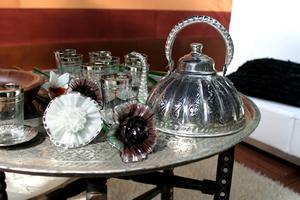 To the naked eye, French silver plate often looks identical to French solid silver. It take close inspection and knowledge of a few key features to reliably tell the difference. Silver plating is the process of applying a thin layer of silver to another, inexpensive, metal, such as nickel or copper. Because of their lower silver content, silver plate items are generally worth less than solid pieces, though old French silver plate is often in demand.
To the naked eye, French silver plate often looks identical to French solid silver. It take close inspection and knowledge of a few key features to reliably tell the difference. Silver plating is the process of applying a thin layer of silver to another, inexpensive, metal, such as nickel or copper. Because of their lower silver content, silver plate items are generally worth less than solid pieces, though old French silver plate is often in demand.
French Silver Plate
Silver plating did not begin in France until the mid-1800s. The process was first invented in England in the 1740s by Sheffield manufacturers. Their technique used a combination of chemical and mechanical means to fix the silver layer. Electroplating started in England in the 1840s and soon spread to France.
Hallmarks
Silver hallmarks are symbols pressed into items to identify the maker, silver quality and other information. The first official hallmarks were established in France in 1260, making them one of the oldest forms of product identification marks for consumers. French silver plate hallmarks are usually contained in a rectangle or square, unlike the traditional lozenge shape found on solid French silver. Flatware marks are frequently located inside a spoon’s bowl or just above fork tines.
Number Marks
French solid silver tends to use symbols and initials for identification, rather than numbers. You can identify French silver plate by a number alongside a maker’s mark. The number refers to the grams of silver used in the electroplating process. So, a spoon may bear the mark “12 G” or “12 Gr,” indicating that 12 g of silver created the item. The number “84 G” or “84 Gr” or similar means 84 g of silver.
Christofle
Charles Christofle was the first maker to introduce French-made electroplated silver to the market. He bought the rights to the electroplating process from the Birmingham manufacturers George and Richard Elkington. The Christofle mark varies over time. Early marks include the initials “G” and “C” with a pair of scales in the middle. Later marks include a cockerel above the word “Gallia” for the Gallia silver range. The word “Christofle” is often found next to the maker’s mark.
Condition
Old or worn French silver plate may look different from antique solid silver. If the silver layer is rubbed too thin, nickel or other base metals may be visible below the surface. This can sometimes take the appearance of dull green or reddish areas. Unlike silver, copper oxidises with air over time and turns green, though nickel is more commonly used in French plate.
French Silver Plate Identification
Written by peter mitchell
Buying French Silver
The following lists show the major manufacturers of silver from France with items commonly found on eBay.
This first list includes those manufacturers who are still extant:
– Christofle at https://www.christofle.com/, sold in Neiman Marcus stores.
– Ercuis at http://www.ercuis-raynaud.com/ANIM/FB7/anim.lasso, sold in Neiman Marcus stores.
– Saint Hilaire is a sub-line of Ercuis featuring gift barware and tabletop accessories
– Puiforcat at http://www.puiforcat.com/
. . . and those no longer in existence or absorbed into one of the above:
– Tetard Freres
– Cardeilhac
– Ravinet Denfert
– Henin
– Odiot
Most of these manufacturers grew significantly in reputation during the Second Napoleonic Empire as was the case with many other silversmiths throughout the world who increasingly benefited from improved production techniques that allowed them to more easily mass produce and sell to the growing merchant class. If a manufacturer is not listed above and you have a piece of silver you are unable to identify the manufacturer of, please check through artiFact.
Solid Silver vs. Silverplate
By far the largest seller on eBay is Christofle. Many uninformed sellers will sell items from Christofle and other silversmiths and label them as Sterling. Very few contemporary items are sterling and if recent will be marked with “sterling” even if produced in France, signifying a 92.5% silver content. Historically there were two standards for “argent massif” (meaning solid silver), these were what is known as Coin Silver in America with an 80% silver content and the more traditional Argent Massif with a 95% silver content. These two solid silver standards are typically indicated by a two predominant symbols most typically a helmeted Minerva head or a winged Mercury head, variations in each of these indicating whether the content is .950 or .800. It should be noted that there are other standards that pre-date these and that are contemporary to these, but these are generally the most common you will find.
Again, as stated earlier, it is only more recently that French manufacturers, who now export extensively, are producing at the universal “Sterling” standard of 92.5% silver content and therefore mark these items with the word “sterling”.
Silverplated items will also have markings, and uninformed sellers will often refer to these markings and indicate they do not understand exactly what they mean but conveniently conclude that they must an indication of solid silver. Any seller who clearly indicates ambivalence on whether or not their item is silverplated more than often has a silverplated item in my experience. Furthermore, many sellers will state that items are “sterling” but when you read the fine print they describe them as “sterling plated” this is more than often intentionally misleading as the descriptor sterling ONLY connotes a solid piece of silver and not a plating.
When it comes to silver plating in French silverware, the standards are quite liberal with no steadfast system but there are a few commonalities:
– “metal blanc” literally means “white metal” and connotes silver plate
– “metal argente” literally means “silvered metal” and connotes silver plate
– a maker’s mark will be included as well as, on older pieces, a number indicating the thickness of metal plating
The good news is that French silver plate, with the exception of Saint Hilaire, is of high quality with multiple layers of electroplating allowing for good durability and silver weight in each piece, especially when compared to American or English silver plated pieces.
French Silver Hallmarks
The vast majority of French silver found today was made after 1838 and will bear only two marks; Silver Guarantee & Maker’s Mark. The left example shows the large guarantee mark (Minerve) & maker’s mark, the right example the small guarantee mark (boar’s head) and maker’s mark. These marks are usually not in close proximity as shown in the examples.

Credit:
http://www.925-1000.com
http://www.metmuseum.org/

